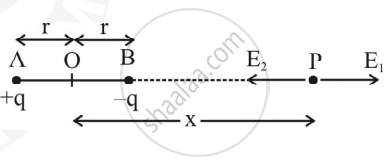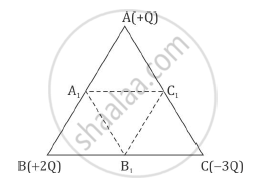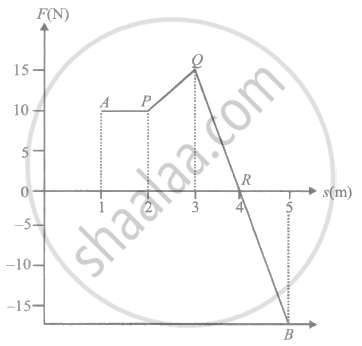Advertisements
Advertisements
Question
Obtain an expression for an intensity of electric field at a point at the end of position, i.e., the axial position of an electric dipole.
x
Solution
Consider an electric dipole consisting of charges –q and +q separated by a small distance 2r in free space.
Let P be a point on the axial line of the dipole at a distance x from the centre O of the dipole.
(i.e OP = x)
Electric field intensity at point P due to +q charge
`E_1 = 1/(4piepsilon_0).q/(AP^2)` (direction A to P)
`e_1 = 1/(4piepsilon_0).q/(x+r)^2` (direction A to P) ...(1)
Electric field intensity at point P due to –q charge
`E_2 = 1/(4piepsilon_0).q/(BP^2)` (direction P to B)
`E_2 = 1/(4piepsilon_0).q/(x-r)^2` (direction P to B) ...(2)
Since E2 > E1 and they act in opposite directions, resultant field intensity is given by :
E = E2 - E1 (direction P to B)
`= 1/(4piepsilon_0).q/(x-r)^2 - 1/(4piepsilon_0) .q/(x+r)^2`
`= 1/(4piepsilon_0).q[1/(x-r^2) - 1/(x+r)^2]`
`= 1/(4piepsilon_0).q[((x+r)^2 -(x-r)^2)/((x-r)^2 (x+r)^2)]`
`=1/4piepsilon_0.q[((x+r+x-r)(x+r-x+r))/(xx^2-r^2)^2]`
`= 1/4piepsilon_0.q [(2x.2r)/(x^2-r^2)^2]`
`E= 1/(4piepsilon_0). (2xp)/(x^2-r^2)^2 `[∵ p = 2r.q]
If the dipole is short (i.e., r << x) then r2 may be neglected as compared to x2
`E = 1/(4piepsilon_0) . (2p)/x^3`
The direction of resultant electric field E is along the dipole axis i.e., from –q charge to +q charge.

APPEARS IN
RELATED QUESTIONS
Three point charges, + Q + 2Q and – 3Q are placed at the vertices of an equilateral triangle ABC of side l. If these charges are displaced to the mid-point A1, B1 and C1, respectively, find the amount of the work done in shifting the charges to the new locations.

In a hydrogen atom, the electron and proton are bound at a distance of about 0.53 Å:
(a) Estimate the potential energy of the system in eV, taking the zero of the potential energy at infinite separation of the electron from proton.
(b) What is the minimum work required to free the electron, given that its kinetic energy in the orbit is half the magnitude of potential energy obtained in (a)?
(c) What are the answers to (a) and (b) above if the zero of potential energy is taken at 1.06 Å separation?
Three point charges +q each are kept at the vertices of an equilateral triangle of side 'l'. Determine the magnitude and sign of the charge to be kept at its centroid so that the charges at the vertices remain in equilibrium.
Why must electrostatic field be normal to the surface at every point of a charged conductor?
A body moves from point A to B under the action of a force, varying in magnitude as shown in the figure. Force is expressed in newton and displacement in meter. What is the total work done?

Three point charges +2, +2, and +5µC are placed respectively at the vertices A, B, C of an equilateral triangle of side 0.2 m. The magnitude of the force experienced by the charge at C is ______.
Two point charges placed in a medium of dielectric constant 5 are at a distance r between them, experience an electrostatic force 'F'. The electrostatic force between them in vacuum at the same distance r will be-
Potential energy of two equal negative point charges 2µc each held lm apart in air is:-
A point charge q0 is moving along a circular path of radius a, with a point charge Q at the centre of the circle. The kinetic energy of q0 is ______.
